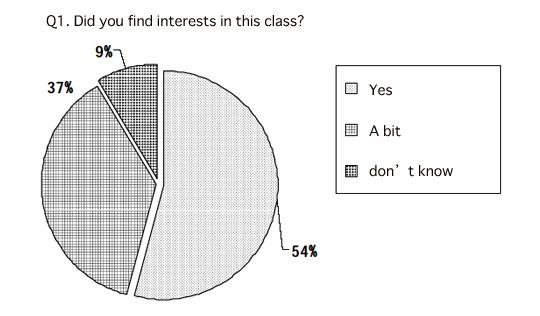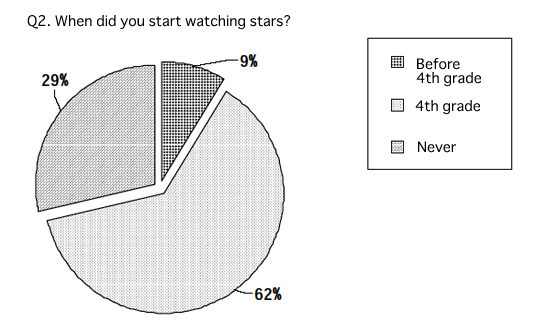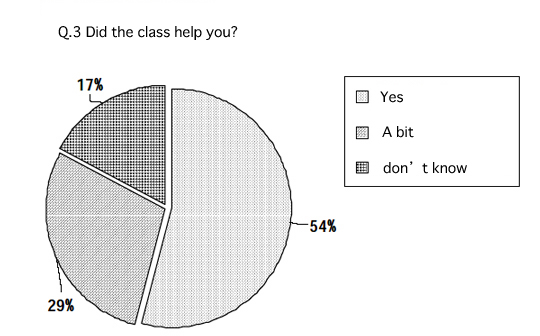HOME|Ideas and resoueces for planetary science experiments|Teraoka Primary School (2002)
宇宙の実験教室
Ideas and resoueces for planetary science experiments
カテゴリ
Category
- 実験教室Idea and Resources for Space science experiments
- 対象項目別Category: Contents
- 学年単元別Category: Study Age
-
- 実践授業Activity Reports
タグ
Tag
 星座の見え方-その2(仙台市立寺岡小学校 2002)
星座の見え方-その2(仙台市立寺岡小学校 2002)
はじめに
はじめに
寺岡小学校では総合学習を「人ってすばらしい」のテーマで行っており、自分の学校から県、国へと広がり、世界に住む人々に ついて学習する中で、特にオーストラリアについて学んでいた。本実践授業の事前には、オーストラリア人の先生からオーストラリアの歴史や習慣についての授業を受けていたが、その中で、オーストラリアでは星座が日本とは逆さまに見えることについて触れた。
本実践授業では、オーストラリアからの星の見え方について、プロジェクターやパソコン、PCカメラ、地球儀を用いた教材(星座の見え方その1、星座の見え方その2 参照)を使って理解することを目的とした。
学習指導案
| 目 的 | 実 施 項 目 |
日本とオーストラリアの星空の見え方の違いを理解しよう
|
実践授業:逆さに見えるオリオン
実践授業:逆さに見えるオリオン
まず始めに、児童に国旗を見せ、オーストラリアについて学んでいることを認識させるようにした。
次に、日本とオーストラリアで同じ星座が見えるかを考えるように指示した。実際にオーストラリアに行ったことがある子の意見によって、 同じ星座は見えるという意見が多数となった。その上で日本とオーストラリアの星空の見え方の違い、特に南半球では逆さに見えるオリオン 座について掲示した。オーストラリアではどのように見えるかということに興味を誘い、教室中央の天井にオリオンを映し出し、そのオリオ ンを教室前後から仰いでスケッチし、オーストラリアからの見え方を実際の視点から疑似体験してもらった(図1)。ここで天井に投影したオリオンをワークシートにスケッチさせた(図2)。
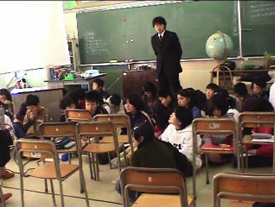 |
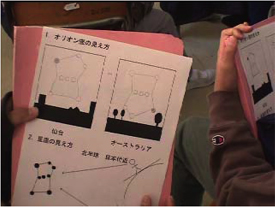 |
| 図1 天井に映したオリオンを見ている | 図2 教室の天井に映したオリオンを教室の前後から仰いでスケッチしたワークシート |
最後に、Webカメラ、パソコン、地球儀を利用した教材を使用した。日本とオーストラリアの位置から撮影した画像2枚を スクリーンに同時投影し、各自がスケッチしたものと比較させた(図3)。これにより、自分の目で観察したことを地球に当てはめて確かめることができた。
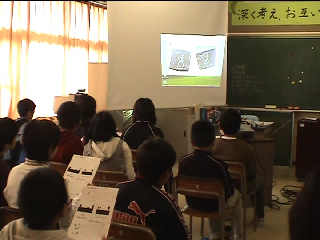
図3 Webカメラの「目」が見た像と自分のスケッチを比較
教室中央の天井にオリオンを映し出すと、児童は日本で見ているものと異なり、逆さに見えることに興味を持ち、不思議がり、多少なりとも驚いているようだった。
地球外からの視点を擬似的に作ることで、児童が苦手とする部分の理解の手助けが出来たと考える。また、オーストラリアでは 日本に足を向けて立っていることは児童には理解が困難であるが、地球儀に人形を付けることで自然とその状態を理解し、より理解を深めることができたように思う。
アンケート結果
アンケート結果
授業後に、生徒35名に対してアンケートを行った。集計結果について以下に掲載する。
総合学習の中において、オーストラリアへの興味を持ってもらうことに少しでも協力できたように感じる。
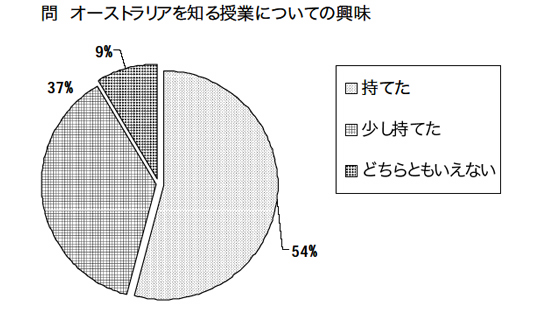
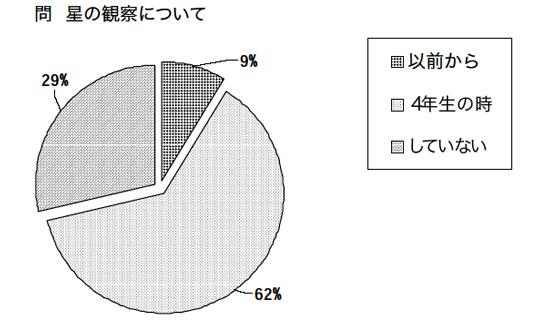
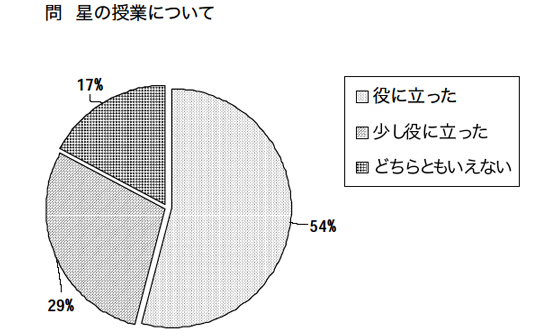
 Teraoka Primary School (2002)
Teraoka Primary School (2002)
Introduction
Introduction
In Teraoka Primary school, they had learned about peopleユs way of life in other countries and especially Australia in integrated study periods, whose theme was "How wonderful people are!". History and customs in Australia was told by an assistant teacher who is an Australian just before this class and also the different visibility of constellations between Australia and Japan was mentioned.
In this class, a projector, personal computer, and web cam were used together with a globe (to show the appearance of a constellation from two reference points on Earth) to help to demonstrate the appearance of the stars from Australia.
Teaching Plan
| Skills Taught | Teaching notes |
To understand the difference in appearance of the night sky between Japan and Australia.
|
|
Sample Class: Orion visible upside-down
Sample Class: Orion visible upside-down
At the beginning of the class, an Australian national flag was shown to remind of that they are learning about Australia. Next,pupils considered whether they think the same constellations will be visible in Japan and Australia. Following a pupil's opinion who has been to Australia, majority of the class agreed that the same constellations will. Then the different appearance of constellations between Australia and Japan was mentioned and especially Orion upside-down from the southern hemisphere. They were interested in how differently it could be seen in Australia. Orion was projected onto a ceiling of the classroom. They sketched it on worksheets from front and back in the classroom which simulated an actual view from Australia.
 |
 |
| Fig.1 Looking at Orion projected onto the ceiling | Fig.2 The worksheet |
At the end, the web cam, computer and globe are set up. Two images taken from a point of Japan and Australia are projected on to a screen at the same time and pupils compared it to their each sketch. This enabled them to apply images they actually watched to images from different hemisphere of earth.

Fig.3 Comparing an image web-camera's "eye" watched to images they sketched.
When Orion is viewed with the projector, it appears to be upside-down that is different from the view from Japan. This causes interests and somewhat surprise to the children.
This practice supported pupils to understand tough part by simulating a point of view from out of the earth. Putting a doll on the globe helped naturally to see that people in Australia stand up with their feet to Japan, which is not easy to understand especially for children.
Questionnaire Results
Questionnaire Results
Questionnaire results received from 35 pupils after the class are given below.
It seems that the class helped them to be interested in Australia.
